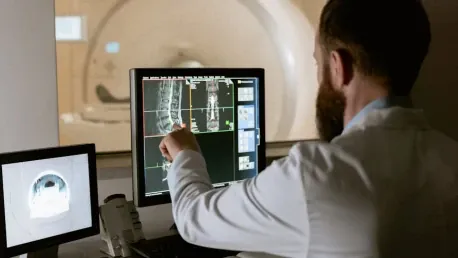The field of radiology stands at the forefront of medical innovations that facilitate improved healthcare delivery. Artificial Intelligence (AI) has emerged as a transformative force within this domain, promising enhanced diagnostic accuracy and efficiency. However, the pressing question remains: Is radiology ready for a thoughtful and strategic AI integration? As AI continues to evolve, radiologists and healthcare institutions must carefully consider its adoption, keeping in mind both the opportunities and challenges it presents. This article delves into a balanced approach to the adoption of AI, underscoring the essential considerations for a successful and sustainable fusion of technology and radiology.
The Need for Continuous Evaluation and Governance
As radiology embraces AI, a critical component of its integration is the continuous evaluation and governance of these technological tools. Dr. Susan Shelmerdine, a consultant academic pediatric radiologist, stresses the importance of regular and systematic assessment of AI applications to ensure they remain aligned with clinical needs. The process must be dynamic, adapting to advancements while scrutinizing the efficacy of existing tools. By maintaining a rigorous evaluation protocol, radiology can prevent the stagnation or misuse of AI technologies, ensuring that these tools continue to provide meaningful clinical benefits.
Governance frameworks play a crucial role in this ongoing evaluation. Effective governance helps prevent inefficiencies and the wastage of resources by ensuring that outdated or underperforming AI systems are promptly upgraded or replaced. Such measures are vital for maintaining the relevance and effectiveness of AI in clinical settings, thereby enhancing patient care. Additionally, governance frameworks support decision-making processes that are transparent and based on clinical evidence, thus fostering a culture of accountability and continuous improvement within healthcare institutions.
Moreover, establishing robust governance ensures that AI technologies are not adopted merely for their novelty but are driven by genuine clinical needs. This approach mitigates the risks associated with adopting tools that may introduce new inaccuracies or inefficiencies in healthcare delivery. The healthcare industry, particularly radiology, must avoid the temptation of chasing technological trends without considering their real-world applicability. By prioritizing clinical efficacy over technological novelty, radiologists can ensure that AI adoption is both pragmatic and beneficial.
Engaging and Educating Patients
Patient engagement is a cornerstone of successful AI integration in radiology. Ensuring that patients are well-informed about the capabilities and limitations of AI tools helps build confidence and trust in these technologies. Dr. Shelmerdine highlights the importance of constructive patient engagement, emphasizing that patients who understand AI’s role are more likely to support its use in their care. Transparency about AI’s functions and limitations can dispel misconceptions and reduce anxiety, ultimately facilitating a smoother transition to AI-enhanced diagnostic practices.
Educational initiatives aimed at patients should provide clear and concise information about AI’s functions, benefits, and potential limitations. This transparency is crucial in managing patient expectations and fostering a sense of security regarding the use of advanced technologies. By offering educational resources and open communication channels, healthcare providers can empower patients to make informed decisions about their care. This empowerment not only enhances patient satisfaction but also contributes to the overall success of AI integration within radiology.
Furthermore, engaging with patients throughout the AI integration process, whether it’s the initial adoption, eventual removal, or the transition between different AI systems, ensures a smooth and acceptable experience for all parties involved. These efforts contribute to a positive perception of AI in healthcare and bolster its sustainable incorporation into clinical practice. By actively involving patients and addressing their concerns, radiologists can create a collaborative environment that maximizes the benefits of AI while minimizing potential drawbacks.
Socio-Economic Implications of AI Adoption
The socio-economic aspects of AI adoption in radiology cannot be overlooked. Dr. Shelmerdine notes that while affluent nations may have the means to rapidly adopt AI technologies, there is a risk that such endeavors are driven more by competition and innovation branding rather than actual clinical needs. This approach could inadvertently introduce new errors and deepen existing health disparities. To avoid such pitfalls, the healthcare community must critically assess the real-world impact of AI technologies, ensuring that their implementation genuinely enhances clinical outcomes.
The economic realities of AI integration include significant setup costs, ongoing maintenance, and necessary operational changes. These factors can be particularly challenging for institutions with limited resources. To address these issues, potential cost mitigation strategies, such as pay-per-study models or phased integration, can be employed to make AI adoption more accessible and equitable. By exploring innovative financial models and partnerships, healthcare providers can overcome economic barriers and ensure that AI tools are available to a broader range of institutions.
Equally important is the consideration of ensuring that AI tools are developed and validated using diverse data sets. This practice helps in creating AI applications that are broadly applicable and effective across different populations, thereby promoting equitable healthcare outcomes. By prioritizing inclusivity and diversity in AI development, the healthcare community can address potential biases and ensure that AI technologies serve the needs of all patients. This approach not only enhances the robustness of AI tools but also fosters a more just and equitable healthcare system.
Balancing Clinical Needs with Technological Innovation
A careful balance between clinical needs and technological innovation is essential for the successful integration of AI in radiology. Dr. Shelmerdine advocates for a strategic approach where AI technologies are adopted to enhance clinical practice and improve patient outcomes, rather than solely focusing on the allure of cutting-edge advancements. By maintaining a patient-centric perspective, radiologists can ensure that AI tools are used to address specific healthcare challenges and improve diagnostic accuracy.
Radiologists and healthcare institutions must critically evaluate the clinical benefits of new AI tools, ensuring that their adoption addresses specific healthcare challenges. This strategic approach helps in avoiding the pitfalls of investing in technology for technology’s sake, which could lead to resource wastage and potential clinical setbacks. By prioritizing clinical relevance and efficacy, healthcare providers can maximize the positive impact of AI on patient care and diagnostic practices.
By aligning AI integration with genuine clinical needs, the field of radiology can ensure that technological advancements translate into meaningful improvements in healthcare. This balance fosters an environment where innovation and clinical efficacy go hand in hand, benefiting both patients and healthcare providers. As AI continues to evolve, this strategic approach will be crucial in ensuring that its integration into radiology is both sustainable and beneficial.
Final Thoughts
Radiology is at the cutting edge of medical advancements, enhancing healthcare delivery significantly. The introduction of Artificial Intelligence (AI) has brought a transformative shift to this field, promising improved diagnostic accuracy and efficiency. Yet, the critical question persists: Is radiology prepared for the thoughtful and strategic integration of AI? As AI technology continues to advance, radiologists and healthcare institutions must conduct a careful evaluation of its adoption, weighing both the opportunities and the challenges it brings. A balanced approach to AI integration is essential to ensure a successful and sustainable fusion of technology with radiology. This necessitates a comprehensive understanding of AI’s potential benefits, such as quicker diagnostic processes and better patient outcomes, as well as its limitations, including data privacy concerns and the need for substantial training for healthcare professionals. By considering these factors, the medical community can adopt AI in a manner that not only optimizes radiology practices but also maintains high standards of patient care and safety.









